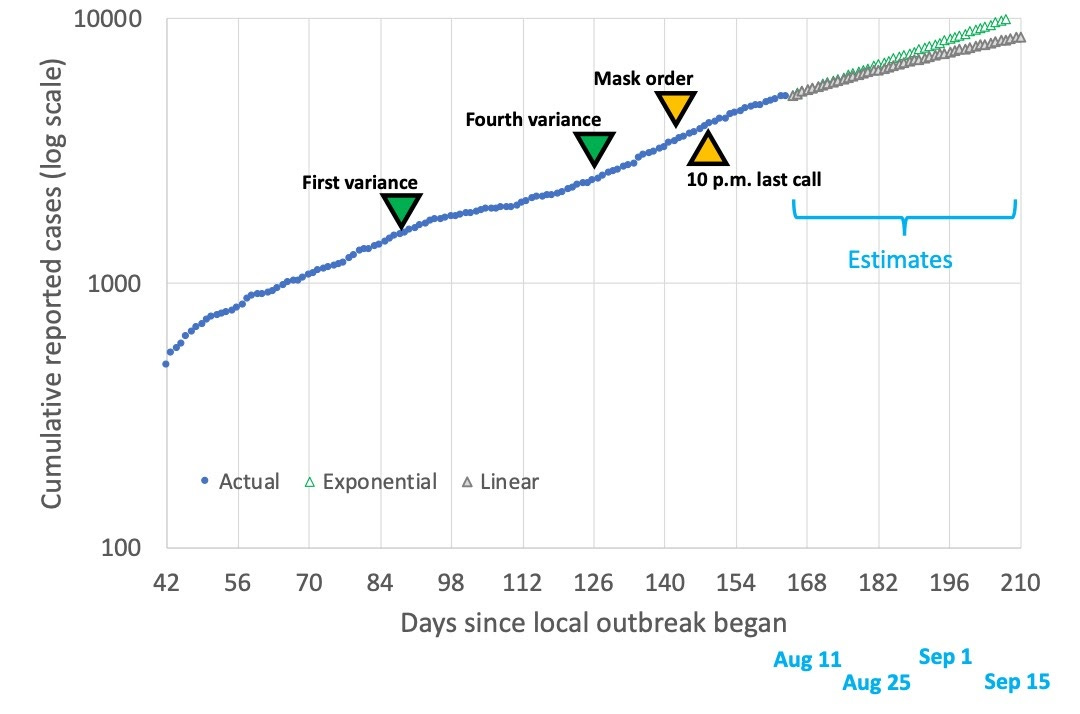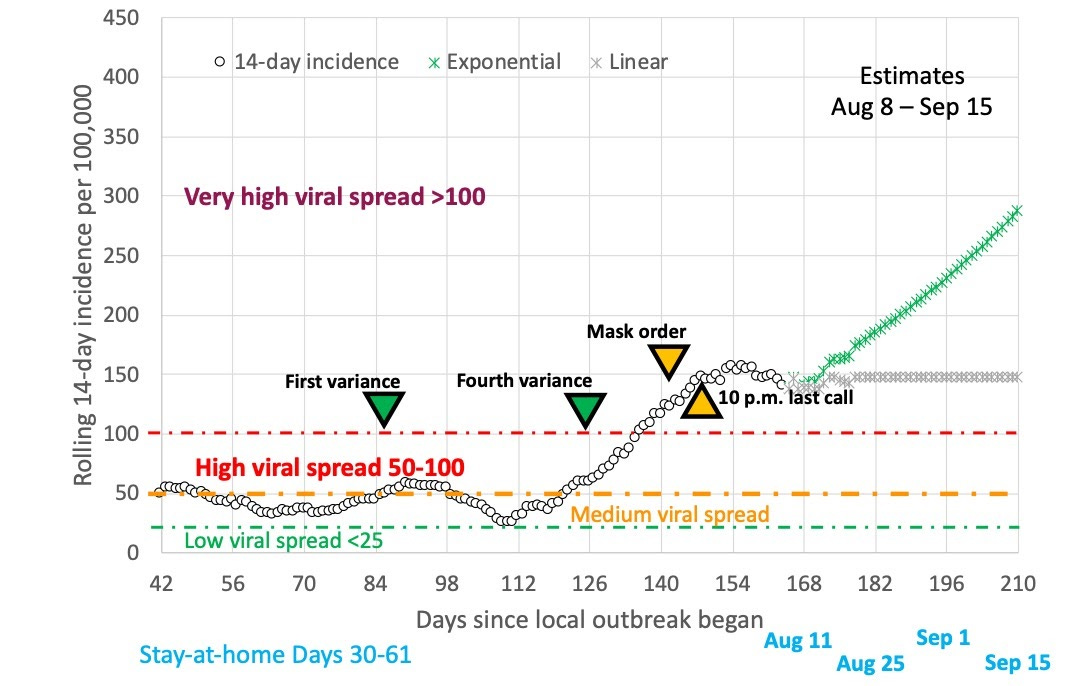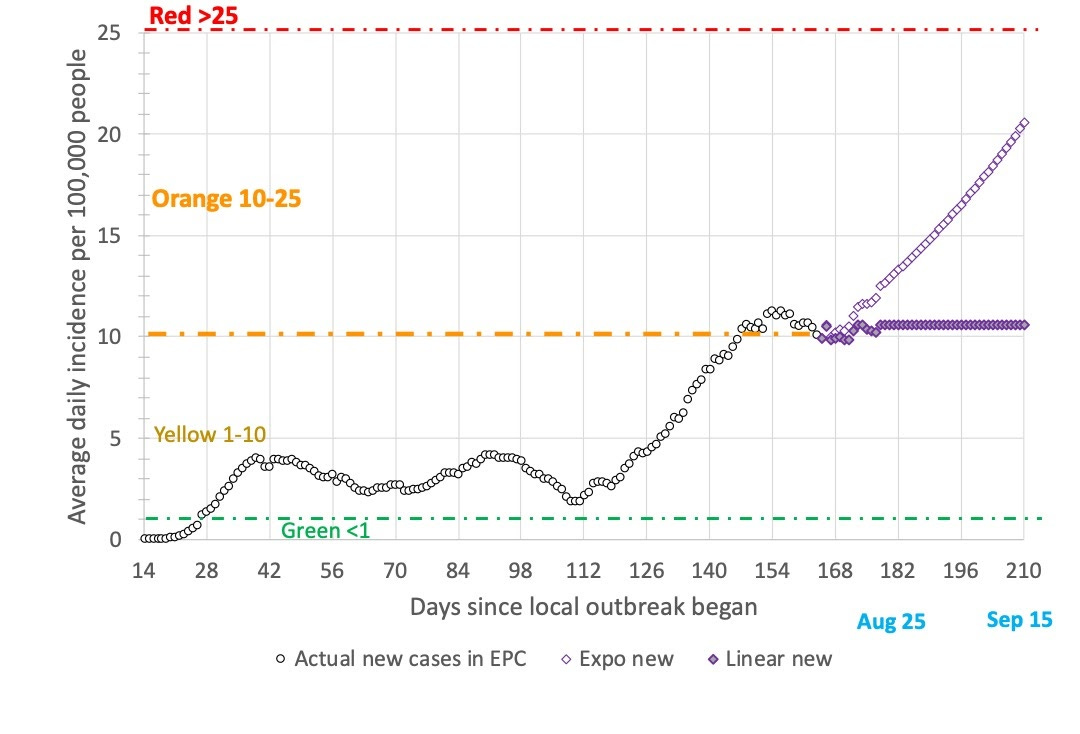COVID-19 Forecast for El Paso County — Aug. 11
Plus, our resident microbiologist on why some schools are testing wastewater for the coronavirus
Good morning, and happy Tuesday. (Was a newsletter-less Monday as weird for you as it was for us?) On this pre-pandemic date last year, ASY TV, an independent TV network, was hosting a Chocolate and Cheese Expo at The Social in Colorado Springs. (The Social doesn’t have any upcoming events scheduled.)
Today, Phoebe Lostroh returns to give her weekly COVID-19 forecast for El Paso County and to explain what wastewater or saliva testing could tell us about coronavirus outbreaks. Lostroh is a professor of molecular biology at Colorado College on scholarly leave who is serving as the program director in Genetic Mechanisms, Molecular and Cellular Biosciences at the National Science Foundation.
➡️ICYMI: On Friday, we introduced ourselves and the infographic team, and explained what you can expect from us as we approach the beginning of the academic year. (If you were wondering why we weren’t in your inbox yesterday, you should give it a read.)
🔌Colorado College student Isabel Hicks ’22 is interning with The Sopris Sun in Carbondale this summer, and she recently published an article about how some local students are preparing for their first years of college. “My friends and I were talking, and we think since we don’t really know what [college] is like, we won’t be too bummed out or feel like it’s too different,” said one incoming Colorado College first-year.
Phoebe’s Forecasts
NOTES: These forecasts represent her own opinion and not necessarily those of the National Science Foundation or Colorado College. She used the public El Paso County dashboard for all data. Lostroh prepared these forecasts on Aug. 8.
⚖️ How her predictions last week shaped up: Aug. 8 is the last day of Morbidity and Mortality Weekly Report week 32 in the national public health calendar. It is the 22nd week since the first case was detected in El Paso County. Since March 13, 139 El Paso County residents have died of COVID-19. Two weeks ago, Lostroh forecasted 5,478 cumulative reported cases for Aug. 7, and instead there were 5,088 cases.
Lostroh attributes the reduced COVID-19 spread to two recent statewide measures:
The statewide mask mandate, which went into effect on July 17.
The ban against serving alcohol after 10 p.m., which started on July 23.
Because the curve is changing so much, the forecast for next week is based on two curves. The first one is the usual exponential fit to the most recent seven days of reliable data. The second one is a linear curve fit. If the reproduction number for a viral infection is one, the disease will increase linearly with respect to time instead of exponentially. So, provided that our behaviors continue to prioritize avoiding spread, Lostroh thinks the next two weeks will fall somewhere between the higher exponential prediction and the lower linear prediction.
Predicted cumulative reported cases in El Paso County

🗝️ Key points: August 24 is day 181 of the local outbreak in El Paso County, which began Feb. 27. It took around 136 days to accumulate the first 3,000 cases, so Lostroh predicts it will take 43-45 days to accumulate the next 3,000. The forecast has improved, but major public health interventions such as universal masks and physical distancing must continue for the time being.
Forecast for COVID-19 cases in El Paso County through Sept. 15

🗝️ Key points: The green triangles show the forecast for a reproduction number greater than one and therefore exponential increase. The grey triangles show the forecast for a reproduction number equal to one and therefore linear increase.
14-day incidence annotated with the state’s viral spread thresholds

🗝️ Key points: El Paso County has exceeded the “high viral spread” threshold since July 10, and Lostroh’s curve predicts the county will continue exceeding it, even in the best-case scenario.
14-day rolling average of daily new cases per 100,000 people in El Paso County

🗝️ Key points: El Paso County was in the yellow zone from March 23 to July 20 and has been in the orange zone since July 21. The prediction using exponential spread is in open purple diamonds while the prediction using a linear increase in cases is in purple diamonds filled with grey.
Lostroh recommends that Colorado College classes should not meet for face-to-face learning until El Paso County is in the yellow condition, which the county is close to achieving. Increased public health measures might help, as would a renewed commitment to staying at home as much as possible, not gathering indoors, and universal mask-wearing outside. It’s still possible El Paso County might reach the yellow zone in time for school to start, Lostroh says.
Q-and-A with Lostroh: Our resident microbiologist on testing noses, saliva — and feces
This interview has been edited for length and clarity.
CC COVID-19 Reporting Project: Brian Young recently told us the college will be testing all students using “near nasal” PCR tests. What does that mean, and how is a “near nasal” PCR test different from other testing methods?
Lostroh: So probably it’s just the anterior nose that they’re using instead of the longer swabs. It just means they’ll swab your nostrils, which virologists are thinking is probably a good idea because it might be less sensitive to detect. It might be harder to detect low amounts of virus there, but people with low amounts of virus, they’re probably not spreading the virus very much either, so it’s okay to use the nose. Increasingly there’s an argument for using saliva, which again, the virus will be less abundant there, but if you’re spreading a lot, it will be abundant enough in saliva to detect. So there’s sort of some debates about whether it would be better to start going with saliva tests if they become available. That saliva test would be a rapid test, rather than a PCR test. The PCR test tests for the genome of the virus, which is made of RNA, whereas the saliva tests that I know about are antigen tests, which test for proteins that are on the surface of the virus.
CCRP: Recent headlines have explored the possibility of testing wastewater for early signs of the coronavirus. Is this a strategy more colleges should be considering?
Lostroh: Yeah, this is a big idea if you could predict that the numbers in a population have gone up by monitoring wastewater. As far as I know it’s still an experimental procedure, but it does work. I mean there are other viruses you can detect that way. And certainly people who have serious cases of COVID-19 can have it in their feces. ... You can detect viral RNA in feces. It’s pretty hard to detect live virus — people have, but it’s rare. Most of the virus that’s there is not live, but it is coming from an active infection. It would be sort of a sign that maybe it’d be a good idea to test that dorm, if you could collect at the place where the water comes out of a single dorm. But I think it’s still experimental.
CCRP: In last week’s Town Hall on testing, administrators said the college is looking into what it would take to develop its own onsite lab with testing capabilities. What would the college need to set up such a lab?
Lostroh: Yeah, you don’t need that much equipment, but you would need a separate facility where there was controlled access so that only very few people could go in and out for safety’s sake. If we were going to have our own on campus, you’d probably set up a trailer or something like that and have like a separate pod where just that lab would be. If a test is positive, you want to know it’s really positive because of the sample and not because of some kind of cross-contamination from someone walking through the lab sneezing. And so you really want to keep that kind of clinical equipment separate. I think there are some schools in the Denver area that are small and that have clinical grade laboratories already because of some of the masters programs that they offer.
About the CC COVID-19 Reporting Project
The CC COVID-19 Reporting Project is a student-faculty collaboration by Colorado College student journalists Miriam Brown and Arielle Gordon, Journalism Institute Director Steven Hayward, Visiting Assistant Professor of Journalism Corey Hutchins, and Assistant Professor of English Najnin Islam. Work by Phoebe Lostroh, Associate Professor of Molecular Biology at CC and National Science Foundation Program Director in Genetic Mechanisms, Molecular and Cellular Biosciences, will appear from time to time, as will infographics by Colorado College students Rana Abdu, Aleesa Chua, Sara Dixon, Jia Mei, and Lindsey Smith.
The project seeks to provide frequent updates about CC and other higher education institutions during the pandemic by providing original reporting, analysis, interviews with campus leaders, and context about what state and national headlines mean for the CC community.
📬 Enter your email address to subscribe and get the newsletter in your inbox each time it comes out. You can reach us with questions, feedback, or news tips by emailing ccreportingproject@gmail.com.


